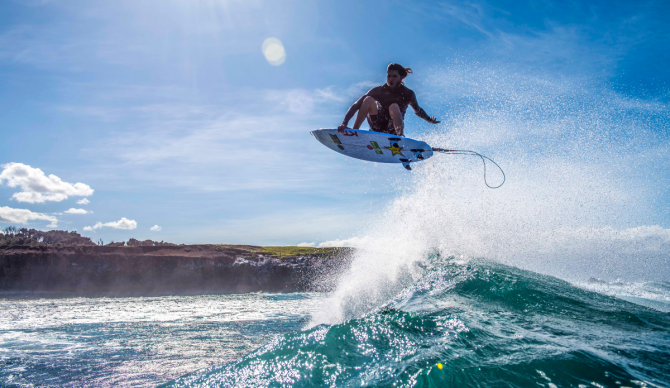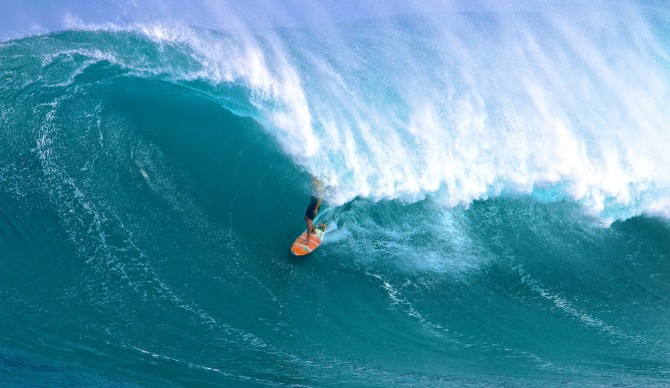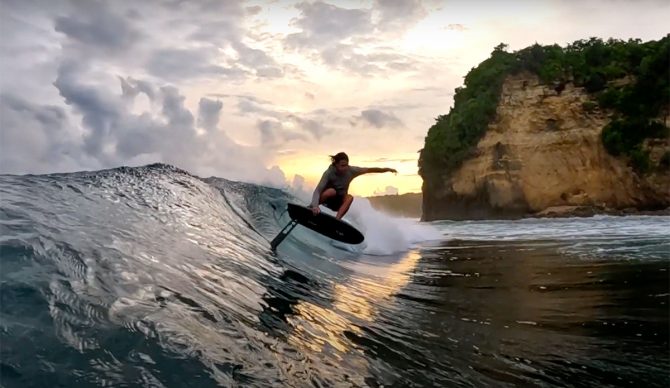
Yes, airs count as a progressive moment in surf. Matt Meola at the forefront. Photo: @1more808//Dayanidhi Das
Pro-gres-sion
noun: the process of developing or moving toward a more advanced state
A thought occurred to me while watching the broadcast of the 2023 Surf City El Salvador Pro a few days back. In one hotly contested heat I saw a competitor take off on a head-high Punta Roca wall and absolutely rip though a series of straight-up-beyond-vertical, spray-throwing, fin-free top turns, punctuated with tight arc carves back into the pocket of a sort that professional competitors of a different generation could only dream of. Yet when the surfer reached the end of the wave, completing a cute little aerial reverse in two feet of whitewater, an event commentator initially lauded not the high-risk, high amplitude surfing performed earlier on the wave, but the whirly-gig on the inside, noting how advantageous adding “progression” to a repertoire can be.
Did that commentator not know that 34 years ago Christian Fletcher won the Body Glove Surf Bout at Lower Trestle performing much more difficult mid-face aerials, or that in the 1994 Cold Water Classic at Steamer Lane Jason “Ratboy” Collins pulled off a wild aerial 360 that earned him a SURFER magazine cover shot? How do maneuvers successfully pulled off in competition over a quarter century ago, let alone today’s less dramatic, almost perfunctory whitewater reverses, qualify as “progressive?” Naturally, this got me to thinking about what advancements in surfing performance can be considered truly progressive. So here’s my Top 10:
10. The Bottom Turn
Old-old timers point to a big day in the 1950s, when during a major south swell at Killer Dana (pre-Dana Point Marina) a young Phil Edwards, surfing alongside the period’s lineup lumberyard on a smaller, more maneuverable balsa board, broke from the traditional pattern of simply angling toward the shoulder, and began turning down to the wave’s trough, weighting the rail, and zig-zagging back up the face. “Suddenly, I was able to cut back and forth along the face of that wave, working it toward the beach” Edwards wrote in his 1967 autobiography You Should Have Been Here An Hour Ago, “while the old-timers were taking them straight in.” From that moment on, it’s been all about turns.

Les Williams and the precursor of rad. Photo: EOS
9. The Cut Back
With a nod to Hawaiian legend Rabbit Kekai, who with the ability to whip his finless Hot Curl out of straight-line trim was the wonder of 1940s Waikiki, credit for the move traditionally goes to Malibu regular Les Williams, who in the early 1950s slashed his way through the status quo on one of proto-designer Joe Quigg’s lightweight balsa “girls boards,” actually re-directing his board back into, and then out of, the curl. Depending on your point of view, the maneuver either ushered in the era of modern surfing (it’s still how we all surf today)…or ruined it (and just like that, you needed to have the wave all to yourself.)
8. Pumping In The Barrel
Effective tube riding had only been around a few years when during the North Shore winter season of 1975-76, a young South African named Shaun Tomson became the sport’s “Anti-Lopez.” With all due respect, of course, Tomson nevertheless deliberately eschewed the Pipe Master’s Zen-like, minimal effort approach to the steep and hollow, choosing, when surfing frontside, to carve his board up and down the face in the barrel, driving, rather than simply flowing through the wave’s deepest sections. Message received: virtually every other skilled surfer Shaun’s age or younger immediately followed his lead.
7. Projection at Honolua Bay
Australian shaper/designer Bob McTavish’s deep vee, transom-tailed “Fantastic Plastic Machines” may not have worked very well at other Hawaiian spots during the winter of 1967 – disastrously, in some cases. But on a beautiful, super-clean day at Maui’s Honolua Bay the surfing world got a glimpse of the future, as under the talented feet of McTavish and ultra-Aussie Nat Young, the weirdly shaped boards with their knifed rails, grotesque vee-panels and flexy fins, visibly sprung out of turns, vaulting their riders to places on the wave previously only imagined. This was the first shot in the “Shortboard Revolution,” and certainly the most impactful.
6. Backside Tube Riding
Yes, back in 1963 teenaged John Peck grabbed a rail and backed up under the shadow line at Pipeline, and sure, Roger Yates was depicted backside barrel flirting at Tamarin Bay in 1972’s Forgotten Island of Santosha. But it wasn’t until that strikingly influential winter of 75-76 that Shaun Tomson, riding backside this time on an over-rockered Spider Murphy pintail, led the paradigm shift at Pipeline, stalling off the bottom and pulling up into the barrel, as opposed to spearing straight through it. Hawaiians Michael Ho, Dane Kealoha, Marvin Foster and Johnny Boy Gomes followed with the “pig dog,” Burleigh Head’s Guy Omerod gave us the layback and Kelly Slater, drawing inspiration from drop-knee bodyboarders, perfected the butt-drag. But it was Tomson who first emphatically asserted that backside was no longer a disadvantage.

Albee Layer, leading the progressive pack at Jaws.
5. Paddle-in Mega Barrels
Watching all the footage of surfers riding spots like crazy Peahi, maxing Mullaghmore, massive Puerto and the North Shore’s pristine “Outer Reefs” – and not just riding but pulling into cavernous tubes on their lay-down boards when only a few years ago they would’ve been happy just to make it to the shoulder – you’d think that this category of progression would sit higher on the list. And it would, had not back in 1977 Hawaii’s James “Booby” Jones successfully campaigned the barrel at Waimea Bay, in a groundbreaking effort that was decades ahead of its time. Not to mention the late Brock Little’s otherworldly Waimea tube in the 1990 Eddie. Still, what the current paddle-in posse has finally got around to doing on their giant boards in giant barrels is pretty frickin’ amazing (see any number of Nathan Fletcher vlogs).
These are perhaps the sport’s most progressive single maneuver…or at least they were when first introduced three decades ago. Surfers have had all that time since to boost higher, spin faster, do various grabs and basically turn a lot of today’s surf clips into trampoline acts. But as fancy surfing goes, it doesn’t get much better than actually leaving the wave and then coming back down, proving that while aerials might be an old trick, they’re still a good one.
3. Figure Eights
The third greatest quantum leap in surf history was made all the more remarkable in that jumping it forward was a guy surfing on his knees. Put simply, in the mid-to-late 1960s, the eccentric California surfer/designer George Greenough did more on his fiberglass spoon kneeboards to shape the direction of modern surfing than anyone before or since. And I mean that literally. With his combo displacement/planing hull, and flexible “high aspect fin,” Greenough shattered the era’s existing standards by carving tight, figure-eight arcs in and out of the pocket with no loss of speed, setting the template that to this day defines high performance surfing.
2. Tow-in Surfing
From the day in 1957 that Oahu’s Waimea Bay was first ridden, to the winter of 1993 on the island of Maui, big, big wave performance was pretty much limited to successfully making it to the shoulder. Greg Noll became “Da Bull” for doing just that at The Bay; Mike “Todos” Parsons for doing the same thing decades later in Baja. But when Laird Hamilton first dropped the rope at Peahi, everything changed, seemingly in an instant. And make no mistake, it was all Hamilton, of his talented crew of cohorts the only guy big, strong and bold enough to completely redefine surfing’s most traditional discipline, carving shortboard turns and stalling for barrels in 40-to-50 foot surf. Then came that day at Teahupo’o, then mind-blowing Cortes Bank, then all those crazy Aussie slabs, then Nazarè and the 100-foot wave…but it all started with Laird at Peahi.

Adam Bennetts following in the footsteps of giants.
1. Foil Surfing
By breaking the planing/displacement hull paradigm, instead tapping into the energy coursing six inches or so below the wave face, foil surfing, as imagined and manifested (once again) by Laird and friends, became the first entirely new form of recreational wave riding in, what, a 1,000 years? Two thousand? No other step of progression even comes close.

